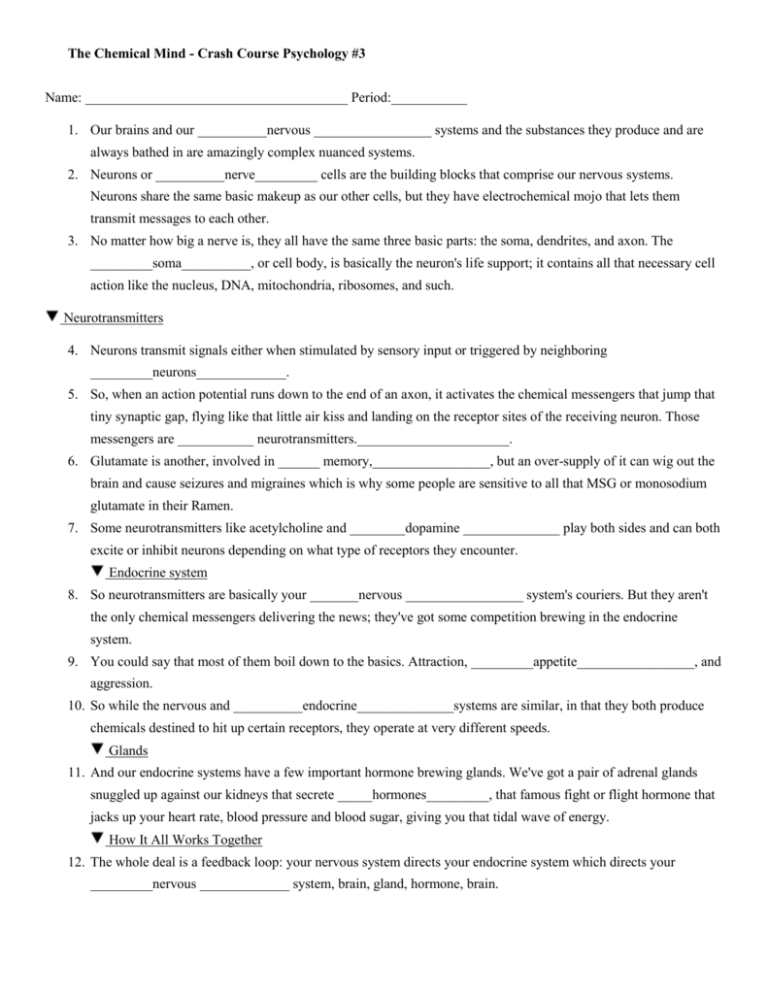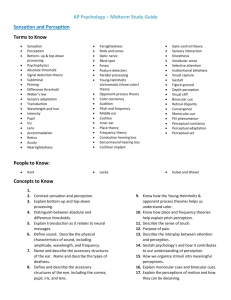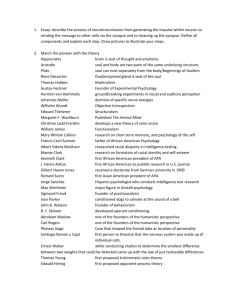Psychology Worksheet: The Chemical Mind & Brain
advertisement

The Chemical Mind - Crash Course Psychology #3 Name: ______________________________________ Period:___________ 1. Our brains and our __________nervous _________________ systems and the substances they produce and are always bathed in are amazingly complex nuanced systems. 2. Neurons or __________nerve_________ cells are the building blocks that comprise our nervous systems. Neurons share the same basic makeup as our other cells, but they have electrochemical mojo that lets them transmit messages to each other. 3. No matter how big a nerve is, they all have the same three basic parts: the soma, dendrites, and axon. The _________soma__________, or cell body, is basically the neuron's life support; it contains all that necessary cell action like the nucleus, DNA, mitochondria, ribosomes, and such. Neurotransmitters 4. Neurons transmit signals either when stimulated by sensory input or triggered by neighboring _________neurons_____________. 5. So, when an action potential runs down to the end of an axon, it activates the chemical messengers that jump that tiny synaptic gap, flying like that little air kiss and landing on the receptor sites of the receiving neuron. Those messengers are ___________ neurotransmitters.______________________. 6. Glutamate is another, involved in ______ memory,_________________, but an over-supply of it can wig out the brain and cause seizures and migraines which is why some people are sensitive to all that MSG or monosodium glutamate in their Ramen. 7. Some neurotransmitters like acetylcholine and ________dopamine ______________ play both sides and can both excite or inhibit neurons depending on what type of receptors they encounter. Endocrine system 8. So neurotransmitters are basically your _______nervous _________________ system's couriers. But they aren't the only chemical messengers delivering the news; they've got some competition brewing in the endocrine system. 9. You could say that most of them boil down to the basics. Attraction, _________appetite_________________, and aggression. 10. So while the nervous and __________endocrine______________systems are similar, in that they both produce chemicals destined to hit up certain receptors, they operate at very different speeds. Glands 11. And our endocrine systems have a few important hormone brewing glands. We've got a pair of adrenal glands snuggled up against our kidneys that secrete _____hormones_________, that famous fight or flight hormone that jacks up your heart rate, blood pressure and blood sugar, giving you that tidal wave of energy. How It All Works Together 12. The whole deal is a feedback loop: your nervous system directs your endocrine system which directs your _________nervous _____________ system, brain, gland, hormone, brain. Meet Your Master: Getting to Know Your Brain - Crash Course Psychology #4 Name: _______________________________________ Period: ____________________ 1. Eventually phrenology was dismissed and was called pseudoscience because it turns out your cranial contours tell us exactly nothing about what's happening inside the ________ brain. __________________. 2. Like we talked about last time, there is a strong link between ______biological _____________ activity and psychological events. Basics of the CNS 3. Your central nervous system, or just _____CNS,_________, is what makes your bodies big decisions. This system is the command center and if you mess with it, things are gonna get weird. 4. What happened to Phineas Gage? explosion caused the rod to shoot like a bullet up through his left cheek and out of the top of his head 5. What did people begin to call Phineas Gage? no longer Gage Basics of the Brain 6. You might have heard that we only used about ___10_____percent of our brains, and oh if that were true, Phineas would lose a quarter of his and he'd be just fine. But in actual reality, brain scans show that nearly every region of the brain lights up during even simple tasks like walking and _______talking______________. Not only that, but the brain itself requires 20 percent of all the body's energy, and it would make little evolutionary sense to throw so much energy away at something that is only minimally active. Ancestral Structures of the Brain 7. This inner core of the brain, sometimes called the "old brain" still performs for us much as it did for our early evolutionary ancestors. It's anchored by the brain stem, the most ancient and central core of the brain where the spinal brain enters the skull. Above it, at the base of the skull, is the _________medulla_____________________. 8. So the old brain systems keep our body's basic functions running smoothly; the sort of stuff any animal might need. This is pretty much where the brain stops for ________ reptiles. ________________. Limbic System 9. The amygdala consists of two lima bean-sized clusters of neurons and is responsible for _____memory _________________ consolidation as well as both our greatest fear and hottest aggression. 10. The final part of the________ limbic________________ system is the hippocampus, central to learning and memory and if it's damaged, a person may lose their ability to retain new facts and memories. New Structures of the Brain 11. Now above all of this is the most advanced stuff - the stuff that you think of when you think of the brain - the grey matter. The two hemispheres of your cerebrum make up at ___85____ percent of your brain weight, and oversee your ability to think, speak, and perceive. 12. Finally, covering the left and right hemispheres we have the cerebral ____cortex___________, a thin layer of over twenty billion interconnected neurons. 13. The frontal lobes, just behind your forehead, are involved in speaking, planning, judging, abstract thinking, and as the tale of Phineas Gage reminds us, aspects of __________personality_______________. 14. The rest of your grey matter is made up of association areas that are related to higher mental functions like remembering, thinking, learning, and ______speaking____________. 15. A legion on a specific part of the temporal lobe may destroy a person's ability to recognize faces, traumatic memories or overactive hormones can profoundly affect our behavior and _____emotions_______________ - all of which remind us how fundamentally biology and psychology are intertwined. Sensation & Perception - Crash Course Psychology #5 Name: _____________________________________ Period:______________ 1. Sacks has a form of prosopagnosia, a neurological disorder that impairs a person’s ability to perceive or recognize faces, also known as ________face__________ blindness. 2. There’s a lot to sense in the world and not everybody needs to sense all the same stuff. So every animal has its limitations which we can talk about more precisely if we define the Absolute Threshold of Sensation, the minimum stimulation needed to register a particular stimulus, ______50______ percent of the time. 3. It’s also about your psychological state; your alertness and expectations in the moment. This has to do with Signal _________ Detection ___________ Theory, a model for predicting how and when a person will detect a weak stimuli, partly based on context. 4. The point at which one can tell the difference is the ________difference _____________Threshold, but it’s not linear. 5. So how do we transform light waves into meaningful information? Well let’s start with the light itself. What we humans see as light is only a small fraction of the full spectrum of electromagnetic radiation that ranges from gamma to ________radio___________waves. 6. So after taking this light in through the cornea and the pupil, it hits the transparent disc behind the pupil; the lens, which focuses the light rays into specific images and just as you’d expect the lens to do, it projects these images onto the _____brain_________, the inner surface of the eyeball that contains all the receptor cells that begin sensing that visual information. 7. What are retinal receptors called? rods and cones. 8. There’s a good deal of ongoing research around exactly how our color vision works. But two theories help us explain some of what we know. One model, called the Young-Helmholtz __________trichromatic __________________ Theory suggests that the retina houses three specific color receptor cones that register red, green and blue and when stimulated together, their combined power allows the eye to register any color 9. But back to your eyeballs. When stimulated, the rods and cones trigger chemical changes that spark neural signals which in turn activate the cells behind them called bipolar cells, whose job it is to turn on the neighboring _____________ganglion_______________ cells. 10. This ability to process and analyze many separate aspects of the situation at once is called ________parallel _____________________Processing. In the case of visual processing, this means that the brain simultaneously works on making sense of form, depth, motion and color and this is where we enter the whole world of perception which gets complicated quickly, and can even get downright philosophical. Homunculus - Crash Course Psychology #6 Name: __________________________________ Period: _______________ 1. This freaky thing illustrates the weighted significance of our_____sensory______________ receptors. His disproportional hands are monstrous, for example, because we primarily touch the world with our hands, not our elbows, so our hands are extremely sensitive. Sound (01:21) 2. Sound moves in _______waves___________ that vibrate through a medium, like air 3. While the human ear might not be as elegant as the jackrabbit's, or as wild as the long-eared bat's, it's actually a pretty incredible _____organ__________. Taste (03:25) 4. Taste is nothing without _____smell___________. Plug your nose in a bite of cold bacon and it's just a mouthful of salt. This is a prime example of sensory interaction; the principle that one sense can influence another Synesthesia (04:25) 5. Most of you said no to all of those questions, but at least one of you out there answered yes. And more likely than not, that person has synesthesia, a rare and fascinating neurological condition where two or more ______senses__________ get wrapped together. 6. Just another example of how the _______mind___________ is still extremely mysterious. Smell (05:49) 7. These receptors send information to the brain's olfactory bulb, then zips it on to the primary smell cortex and parts of the limbic system responsible for emotion and _______memory_____________. 8. The emotional power of smell partly has to with how our sense circuitry connects to the brain's limbic system, right next to our emotional registry, the amygdala, and our _________memory_____________keeper, the hippocampus. That's why scents can be so intimately tied with our feelings and _______memories__________________________. Touch (07:23) 9. Smelling, hearing, tasting, seeing, all fantastic, but if there's one thing that popular music taught us, besides a bunch of really terrible relationship advice, it's that when it comes to our senses, we're all about ________touching_______________________. 10. Your sense of touch is actually a combination of four distinct skin sensations: pressure, warmth, cold and __________pain_____________________. 11. The partner sense to your kinesthesis is your____________vestibular ____________ sense, which monitors your head's position and your balance. Outro (09:39) 12. For now, hopefully you realized that your homunculus is actually kinda beautiful, in its own way, because you learned how your sense of hearing, taste, smell and ____touch______ work. Perceiving is Believing - Crash Course Psychology #7 Name: ______________________________ Period: _____________ 1. Our perception, or how we order the cacophonous chaos of our environment is heavily influenced, biased even, by our expectations, experiences, moods, and even _______ cultural_______________ norms. 2. Without the ability to interpret _____scent_______, we couldn't differentiate the smell of toast from a grease fire. Part One: Perceptual Set 3. What kind of bird do you see right now? A _____duck_______, right? But if I said: "What kind of mammal do you see?", a ________bunny___________probably would've popped out at you. Now, you should be seeing both of them popping back and forth. 4. And that's an example of how culture is also an important part of our perceptual set. As much as our perceptions are affected by context and expectations, they're also swayed by our emotions and ________motivations___________________. 5. But we've come to discover that it is quite complicated, so complicated that we have a name for it: "_____form________ perception." Part Two: Form Perception 6. We're also drawn to organize our world with attention to continuity: perceiving smooth, continuous patterns and often ignoring ______broken____________ones. 7. Form perception is obviously crucial to making sense of the world, or, you know, a moderately interesting party. But imagine trying to navigate the world without _____depth____________perception. Part three: Depth perception 8. Depth perception is what helps us estimate an object's distance and ____full______ shape: in this case, a nice shape that is currently too far away from you. It is at least partially innate. Part Four: Visual cues 9. We're able to perceive depth by using both binocular and monocular visual cues. ________Binocular___________ cues, as the name gives away, require the use of both eyes. 10. We use motion perception to infer speed and direction of a moving object. Your brain gauges motion based partly on the idea that shrinking objects are retreating, and enlarging objects are __________approaching._________________________. 11. What allows us to continue to recognize an object regardless of its distance, viewing angle, motion, or illumination? Perceptual constancy Conclusion 12. And if you were correctly constructing your perceptions this lesson, you learned what forms your perceptual set, how form perception works, and the many visual cues that influence your ______________depth perception._______________________________________.








